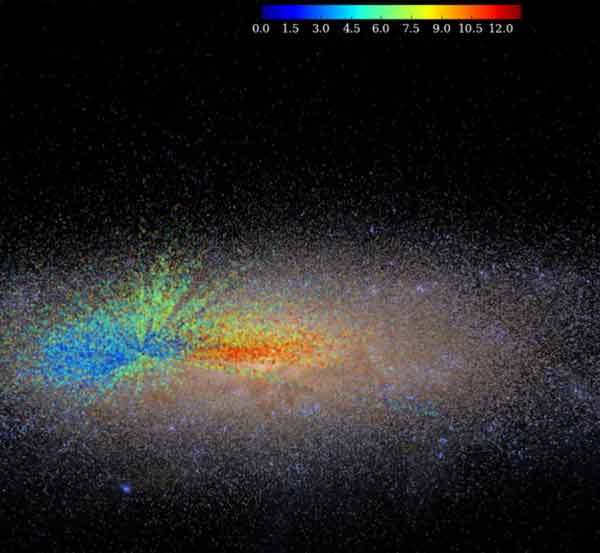
Florida, US (BBN)-Astronomers have measured the age of 70,000 stars across the Milky Way and put the results into a galactic map.
It confirms what was already suspected about our galaxy's growth: it started in the middle and grew outward, reports BBC.
This can be seen in the abundance of old stars near the centre of the disc.
Presented at the 227th meeting of the American Astronomical Society in Florida, it is the largest such map ever assembled.
"We're characterising in really unprecedented detail how the galaxy is formed, via this snapshot of stellar ages across the disc," lead researcher Melissa Ness told the BBC.
The tendrils of the map extend out from the Earth, beyond the centre of the galaxy in one direction, and out to the very far reaches of the disc in the other.
"And we not only have these ages in the plane of the disc, but also moving up above the galactic plane," added Dr Ness, who works at the Max Planck Institute for Astronomy in Germany.
To calculate the age of each star, she and her colleagues used data from two telescopes.
Firstly, the Apogee project - part of the ground-based Sloan Digital Sky Survey - sampled many thousands of stars, 300 at a time, using a wide swathe of wavelengths.
These spectra help astronomers to work out the chemical composition of stars, but cannot determine their age directly.
So the team started with a subset of stars that had also been observed from space by the Kepler satellite.
This telescope stares at a few stars for a long period of time, and can establish their mass.
"If we know the mass of these Kepler stars, we can determine their ages," Dr Ness explained.
This enabled her team to build a model relating a star's mass and age to its colour spectrum, from the Apogee data.
That model could then be deployed to calculate ages for all the remaining stars, based purely on their spectra.
ONE FOR THE AGES
"This is somewhat revolutionary because ages have previously been considered very hard to get, particularly from stellar spectra," Dr Ness said.
"They're important, but they're difficult."
Other techniques for gauging a star's age, like watching it spin, are much more painstaking.
"This is really the first time that we've been able to infer ages for such a large number of stars, rather than relying on this small subset of stars with special observations."
All the stars in the map are red giants - a very good place to start, Dr Ness explained, when peering across half a galaxy.
"These are an extremely valuable star to get ages for, because they are very bright and we see them at very large distances."
And, she added, this cosmic slice of age statistics paints a pretty clear picture: "Our galaxy started out as a small disc, and it's grown from the inside out.
"That's something we very much suspected, but now we have the details that confirm all of this - because we couldn't know for sure, based on stellar ages just for stars nearby our Sun."
BBN/SK/AD